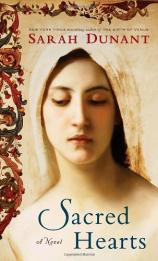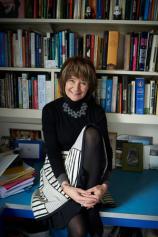Sacred Hearts
Review
Sacred Hearts
From THE NUN’S STORY to IN THIS HOUSE OF BREDE,
from BLACK NARCISSUS to MARIETTE IN ECSTASY, novels about nuns have
been an enthusiasm of mine since girlhood. The spare, contemplative
life of the convent, the “marriage” to Christ, the
drama of doubt and temptation: All this was inconceivably romantic
to someone raised without a drop of religion. Although I
hadn’t yet experienced love or sex --- those mysterious
objects of desire still hung in the misty, hypothetical future ---
I was fascinated by the decision to forgo them entirely. It seemed
enviably pure.
Pure is not the word that comes to mind when the reader
is introduced to the sisters in SACRED HEARTS, the third of
Sarah Dunant’s wonderful historical novels (her previous two
took place in Florence and Venice; this one in Ferrara) --- they
are altogether more worldly souls. In the late 16th century, it
seems, extraordinary faith was not a prerequisite for taking vows;
often nuns were women who were simply losers in the marriage
market. Perhaps they suffered from physical disabilities (cleft
lip, twisted spine), or they were from families that couldn’t
afford to see them properly wed (in an Author’s Note we learn
that dowries had become so inflated that by 1600 nearly half of
Italian noblewomen were destined to become nuns!).
Although some convents at the time were humble affairs, Santa
Caterina, the fictional setting for SACRED HEARTS, is hardly
a closed-off spiritual enclave. One nun has a pet dog; others write
plays and compose choral music; all are able, on designated
occasions, to meet face-to-face with family.Their cells, often
containing such amenities as books, carpets and satin sheets, are
cleaned by lay servants. The community is a business entity,
producing and trading in illuminated manuscripts and painted
religious figurines, herbal medicines and embroidered church robes,
as well as a political one, competing with other convents to win
patronage and fame.
Suora Zuana, the dispensary mistress --- the closest thing Santa
Catarina has to a doctor --- makes the ironic point that women are
often better off within the convent than they would be in the
outside world: “[T]here are no fathers to bully or rage at
the expensive uselessness of daughters, no brothers to tease and
torment weaker sisters, no rutting drunken husbands poking
constantly at tired or pious wives.” And in the remarkably
democratic institution of the chapter meeting, each nun “has
a voice and a vote” on everything from what they will eat to
whom they will have as Abbess.
The daughter of an enlightened medical man whose sudden death left
her nowhere else to go, Zuana is essentially a scientist plopped
down in the middle of a religious community. For 16 years she has
wrestled with the demands of faith and her own conscience, although
she has also found a certain tranquility at Santa Caterina. She is
the person the reader will most identify with: open-minded,
self-doubting, curious, caring and practical --- a modern heroine
underneath her habit.
She finds herself caught between two opposed convent
philosophies. On the one hand there is the mysticism and orthodoxy
of Umiliana, the sharp-tongued, frighteningly intense sister in
charge of the novices (those who haven’t yet taken final
vows). But there is also the penchant for realism and diplomacy
epitomized by the Abbess, Madonna Chiara, a natural politician who
sees no conflict between serving God and glorifying her family.
This power struggle --- isolation and repression versus worldliness
and liberality --- mirrors the one taking place in the Catholic
world of the late 1500s in the wake of Martin Luther’s
accusations of sin and hypocrisy. Change is looming, and Zuana,
Umiliana and Chiara are fighting, each in her own way, for the
survival of Santa Catarina in troubled times.
They are also fighting for the soul of Serafina, the newest
novice. This high-born young woman has been sent to the convent as
punishment for falling in love with her music teacher, and her
angry presence rocks Santa Catarina to its foundations. Although
reputed to have a stunning voice, she uses it to scream in the
night, not sing in the choir; with her desperate plots, anorexic
extremes (she is, after all, a teenager), quick wit and personal
charm, she tests the limits of Chiara’s pragmatism,
Umiliana’s fanaticism and Zuana’s compassion.
The drama of SACRED HEARTS is intensified and distilled by
Dunant’s decision to set the novel entirely within the
convent walls and to alternate her narrative between Zuana’s
point of view and Serafina’s --- the ambivalent veteran and
the ardent, angry newcomer. The color and detail of her writing is,
as always, astounding; by the end of the book I felt that I knew
Santa Caterina intimately and could sense the solemn rhythm of the
convent’s daily offices, from Lauds to Matins.
I won’t go into the denouement, because
Dunant’s plot is as riveting as that of any thriller. But it
isn’t giving anything away to say that, ultimately, orthodoxy
wins out, as the Abbess anticipates (she tells Zuana to memorize
her medical books, for soon she won’t be allowed to have
them). By 1600, says the Author’s Note, new convent rules
were being imposed. Contact with the outside world was
“brutally restricted”; plays and music were banned, and
luxuries and private possessions confiscated.
There is a modern echo of such a shift in the Vatican’s
recent investigation of American nuns, who are apparently suspected
of being overly secular and insufficiently devout.* Zuana and her
Abbess would, I am sure, take a dim view of this development.
SACRED HEARTS suggests that it is possible, though difficult, to
follow a consistent spiritual practice while using your brains and
talents to engage in work that makes a difference in the world. It
says that sisterhood is powerful.
*According to a New York Times article from July 2,
2009
Reviewed by Kathy Weissman on January 23, 2011
Sacred Hearts
- Publication Date: July 14, 2009
- Genres: Fiction, Historical Fiction
- Hardcover: 432 pages
- Publisher: Random House
- ISBN-10: 1400063825
- ISBN-13: 9781400063826





